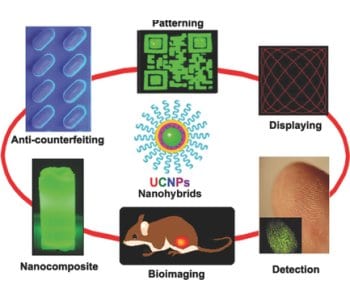In recent years, lanthanide-doped upconverting nanoparticles (UCNPs) have aroused tremendous interests in many scientific fields due to  their unique luminescent properties (so-called anti-Stokes emission). Phosphors in most cases demonstrate the optical property of down-shifting emission, that is, the higher energy photons are absorbed while lower energy ones are emitted due to internal energy loss. In the other words, down-shifting luminescence is a process from short wavelength light excitation to long wavelength irradiation. On the contrary, the UC process outputs radiation at a shorter wavelength than the pump wavelength. UCNPs have the ability to convert long-wavelength near infrared (NIR) light to a shorter wavelength light including NIR, visible and even ultra violet (UV) light. In these processes, lanthanides play a key role because of their special intermediate levels and the long lifetime. With the rapid progress of nanoscience and nanotechnologies,many exciting results have been achieved in this fantastic field over the past ten years. Owing to the merits of NIR excitation – excellent chemical stability, narrow emissions, non-blinking and so on – UCNPs offer good prospects in displays, bioimaging, bioassays, drug delivery, sensors and anti-counterfeiting applications. Especially in biomedicine, UCNPs are promising candidates to become a new class of luminescent probe due to the higher tissue penetration depth and low background fluorescence of NIR excitation, which are superior to the conventional organic dyes and quantum dots.
their unique luminescent properties (so-called anti-Stokes emission). Phosphors in most cases demonstrate the optical property of down-shifting emission, that is, the higher energy photons are absorbed while lower energy ones are emitted due to internal energy loss. In the other words, down-shifting luminescence is a process from short wavelength light excitation to long wavelength irradiation. On the contrary, the UC process outputs radiation at a shorter wavelength than the pump wavelength. UCNPs have the ability to convert long-wavelength near infrared (NIR) light to a shorter wavelength light including NIR, visible and even ultra violet (UV) light. In these processes, lanthanides play a key role because of their special intermediate levels and the long lifetime. With the rapid progress of nanoscience and nanotechnologies,many exciting results have been achieved in this fantastic field over the past ten years. Owing to the merits of NIR excitation – excellent chemical stability, narrow emissions, non-blinking and so on – UCNPs offer good prospects in displays, bioimaging, bioassays, drug delivery, sensors and anti-counterfeiting applications. Especially in biomedicine, UCNPs are promising candidates to become a new class of luminescent probe due to the higher tissue penetration depth and low background fluorescence of NIR excitation, which are superior to the conventional organic dyes and quantum dots.
Within all these applications, polymer plays an irreplaceable role in improving the properties of UCNPs such as synthetic methodology, processibility, biocompatibility, water solubility, functionalities, and stimuli-responsive behavior. Synchronously, polymers offer tremendous opportunities for constructing novel functional nanomaterials in combination with UCNPs. Read more about the most recent progress in UCNPs/polymer-based nanohybrids and the emerging applications in a review article by Jun Lin and Ziyong Cheng (Changchun China).

















